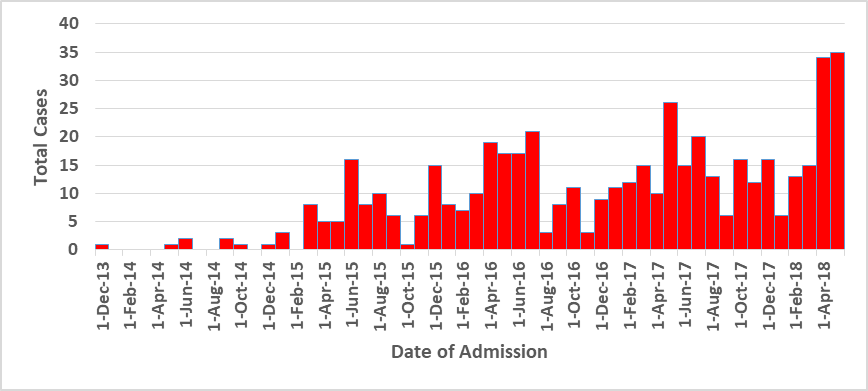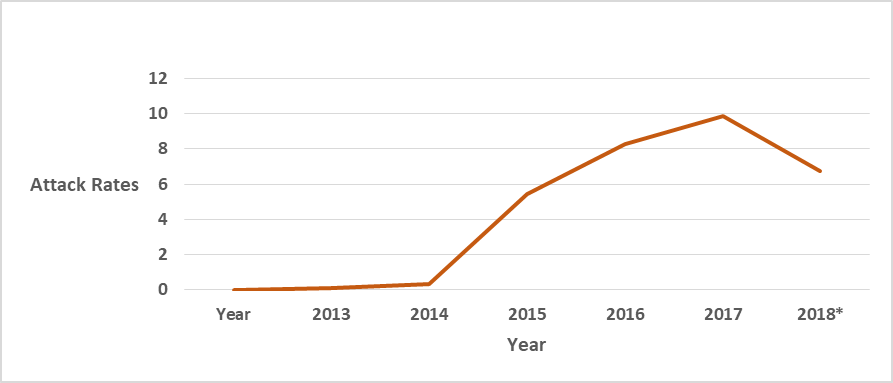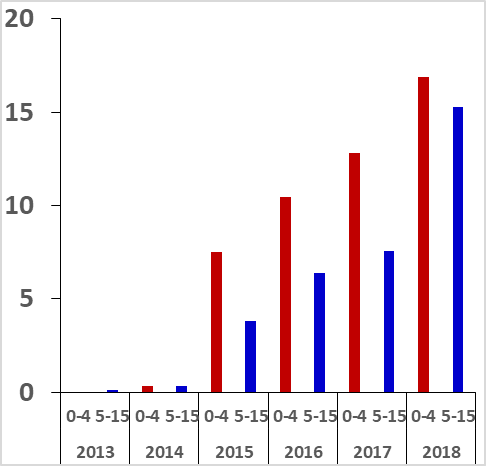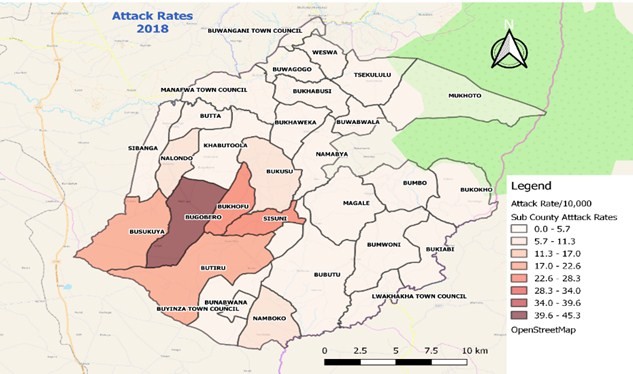Suspected Black Water Fever among children in Manafwa District, Eastern Uganda, 2018
Authors: Esther Kisaakye1*, Bernadette Basuta1, Daniel Eurien1, Lilian Bulage1, Alex Riolexus Ario1; Affiliations: Uganda Public Health Fellowship Program, Uganda
Summary
On 23 May 2018, Bubulo East Member of Parliament reported a strange disease affecting children in Manafwa District in Parliament of Uganda. We investigated to determine the existence, scope, nature of the strange disease and recommend evidence-based control measures. We line listed 500 cases with case fatality rate of 6.4% (32/500). Cases increased gradually over years from 2013 to 2018 but markedly from 2015 to June 2018. Children 0 to 4 years and male sex were most affected. Of the 11 (both blood and urine) samples analyzed, 9/11 tested positive for malaria and had anemia, 8/11 had neutropenia and leukopenia. We concluded that the strange disease was likely to be black water fever (BWF). We recommended further investigations to establish the true exposures, and support for emergency management of case-persons.
Background
Black water fever is a serious complication of malaria infection with haemolysis releasing haemoglobin directly into the blood and the urine leading to severe jaundice, anuria, kidney failure and death in the majority of cases(1). It is thought to be an autoimmune reaction caused by the interaction of the malaria parasites (Plasmodium Falciparum) and antimalarial drugs like quinine (2). On 23 May 2018, Bubulo East Member of
Parliament reported a strange disease affecting children in Manafwa District in Parliament of Uganda. We investigated to determine the existence, scope, nature of the strange disease and recommend evidence-based control measures.
Methods
We defined a suspected case as onset of dark /red urine and any of the following: high grade fever, loss of appetite, fatigue, abdominal pain, abdominal distention, anemia, jaundice, headache, vomiting, palpitations and painful urination in a resident of Manafwa District since 2013. We reviewed medical records and conducted active community case-finding. We described cases by time, place and person characteristics. We
collected and analyzed blood and urine samples for 11 suspected cases.
Findings
From January 2013 to June 2018, we line listed 500 case-persons of which 32/500 were reported to have died. (Case fatality rate=6.4%). Cases admitted at health facilities increased gradually over years from 2013 to 2018. (Figure1). More case-persons were reported in 2017 (AR=9.84, 114/169861) (Figure 2).


Figure 2: Attack rates of black water fever per year
All Case-persons presented with dark/red urine (100%), high grade fever (95%), anemia (86%) and jaundice (68%)` presented with jaundice. The number of the affected sub-counties increased over years from only one in 2013 to sixteen by June 2018. Incidence was higher in 0-4 than in 5-15 year age group (Figure 3) and males had slightly higher rate than females.

Based on the 32 care takers interviewed, 69% (22/32) cas-persons started getting episodes of the illness between 1 to 2 years and all case-persons have been having recurrent episodes which subsided on treatment with anti-malarials and antibiotics. 50% (16/32) of the case persons had ≥10 episodes since onset of illness and 44% (14/32) of the casepersons experienced episodes every 1 to 2 weeks. Bugobero (945/10,000) was the most affected followed by Bukhofu (22/10,000), Sisuni (22/10,000), Busukuya (20/10,000), and Butiru (18/10,000). (Figure 4)

Laboratory findings
There was anemia in 9/11 samples, neutropenia and leukopenia in 8/11, 9/11 tested positive for malaria by RDT, 3/11 tested positive for plasmodium falciparum by microscopy and Sickle cells in 1/11 samples. There was no schistosoma haematobium ova, protein, and bilirubin in all urine samples.
Discussion:
Cases presented with dark /red urine and any of the following: high grade fever, loss of appetite, fatigue, abdominal pain, abdominal distention, anemia, jaundice, headache, vomiting, palpitations, sweating and painful urination typical of black water fever a serious complication of severe malaria (5).
While there is little information on black water fever in Uganda, we found that this disease has occurred in Manafwa District since 2015. We found that it affected children (4 months to 16 years) with frequent episodes of severe malaria who got treated with intravenous antimalarial drugs like quinine and artesunate.
Several studies have revealed that treatment with anti-malarial drugs such as quinine, artesunate, halofantrine, mefloquine, artemether-lumefantrine can trigger the occurrence of black water fever among non-immune individuals (6). However our investigation was not able to identify trigger factors for this disease.
Conclusion & Recommendations
Our findings revealed that the strange disease was likely to be black water fever. We recommended, further investigations to establish the true exposures to the disease and provision of logistical support for emergency management of case-persons.
References
1. Glanantonio CA, Vltacco M, Mendilaharzu F, Gallo GE, Sojo ET. The hemolytic-uremic syndrome. Nephron. 1973;11(2–4):174
–192.
2. Van den Ende J, Van den Ende J, Coppens G, Verstraeten T, Van Haegenborgh T, Depraetere K, et al. Recurrence of blackwater fever: triggering of relapses by different antimalarials. Trop Med Int Health. 1998;3(8):632–639.
3. Nankabirwa V. Child health in a Ugandan cohort: Studies on survival, vaccination and malaria. 2011;
4. Buffet PA, Safeukui I, Deplaine G, Brousse V, Prendki V,Thellier M, et al. The pathogenesis of Plasmodium falciparum malaria in humans: insights from splenic physiology. Blood. 2010;blood–2010.
5. SHEEHY TW, REBA RC. Complications of falciparum malaria and their treatment. Ann Intern Med. 1967;66(4):807–809.
6. Daubrey-Potey T, Die-Kacou H, Kamagate M, Vamy M, Balayssac E, Yavo JC. Blackwater fever during antimalarial treatment in Abidjan (West Africa): report of 41 cases. Bull Soc Pathol Exot 1990. 2004;97(5):325–328.


Comments are closed.